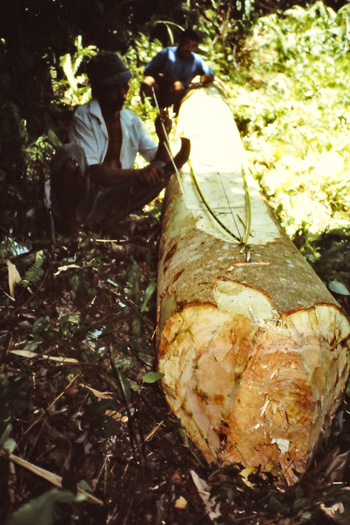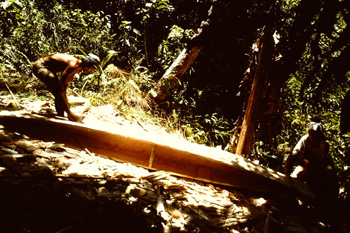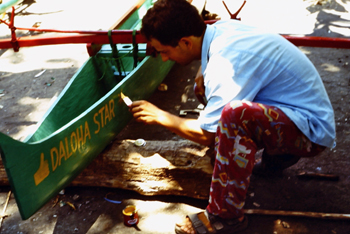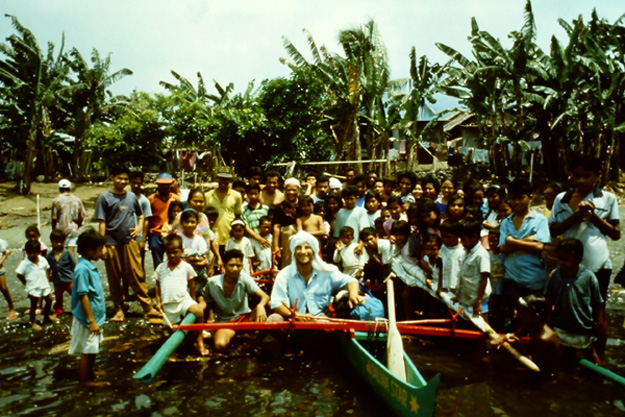By Bicycle to Kathmandu
The Anthro Department has a new faculty member. Götz Hoeppe arrived
in Williamsburg, as he arrived at anthropology, by circuitous routes, by
a kind of conceptual as well as geographical stochastic stroll across
the world. An early fascination with astronomy was tempered just enough
by his parents' subscription to the National Geographic magazine to
result in a complex world view which encompasses stars, boats, cultural
enquiry and a firm commitment to the richness of human life. What could
be more anthropological than that?
First things first. ‘Götz' is
a contraction or variant of ‘Gottfried', a much more familiar kind of
moniker. "Even in Germany people ask about my name!" he confesses. We
are already getting used to it. Götz Hoeppe is German (although born in
Singapore) and grew up in Wittzenhausen in the heart of fairytale
country, where the brothers Grimm first gathered many of their eerie
tales. (The castle in a nearby town was the original of the
vine-covered resting place of Sleeping Beauty.)
Childhood
telescopes gave way to math, physics and the other higher order
components of modern cosmology. When grad school beckoned, Hoeppe
decided to make a break from familiar surroundings, ending up at the
University of New Mexico studying physics and astronomy.
"What
could be more different from Germany than New Mexico? It is so
beautiful, and it's still one of my favorite places" he says. Nor did
it offer an escape from the lure of the anthropological. While at New
Mexico he continued to take anthropology courses, continuing an
undergraduate interest.
"The first thing I did was buy a
motorcycle. When I needed to get away from school and physics, I'd ride
out to Acoma or Laguna. I was drawn to the reservation villages – and I
came to like sleeping out in the desert behind Acoma pueblo." He also
brought his telescope with him to Zuni Pueblo middle school to talk
about the stars and to show students cosmological objects through the
telescope. A Zuni elder was delegated to make sure the proper respect
was paid to those cosmological beings during these outings –
anthropology literally looking over his shoulder.
His
astronomical work led, after graduation, to a proposed involvement in a
project at the Australian Telescope Compact Array. The telescope time
was scheduled a year in advance, and Götz found himself back in Germany
with time on his hands. He decided to go to Australia ‘overland' (or
‘oversea' – his goal was to avoid air travel completely if possible),
organizing his travel around astronomical colleagues and institutions. A
planned trip on the Trans-Siberian Railway was ditched at the last
minute when an opportunity to go East via the Silk Road opened up.
Samarkhand, Bukhara and other fabled central Asian cities led on, by
bus, from Turkmenistan to Kyrgystan and then to China.
Buses
go to Tibet too, and in Lhasa Hoeppe ran into an American traveling by
bike. A nice change from buses, apparently – "It seemed like a great
idea!". And so Götz bought a bicycle and rode ("Well, pushed is more
like it...") it over the Himalayas to Kathmandu. From there he
cris-crossed the subcontinent to Madras, where he bought a used copy of
Levi-Strauss' "Structural Anthropology' and ended his air embargo when
he discovered that the freedom offered by tramp steamers came with too
many strings.
But something had happened along the road, and India crystallized it in some undefinable way. Arriving in Indonesia, although he was nearing his geographical goal, his intellectual goal was less clear. On a ferry in the Moluccas he befriended a local girl who directed him to her uncle in a village on the coast. Her uncle, she assured him, could help him build or acquire an out-rigger canoe, a long held dream of his. He also had an idea of finding out about what relationship existed between these sea going people and his beloved stars. Armed with a letter of introduction to a man who turned out never to be found, he went to the village and stayed for four months. There he got his canoe, the ‘Daloha Star' (transformed from tree into boat during his stay), and took it through the islands to New Guinea. By the time he got to Australia he knew that, other than chronologically, he was an anthropologist before he was an astronomer.
 |
 |
 |
|
| The tree that became the Daloha Star | Construction of the Daloha Star |
Götz Hoeppe's new track took him eventually to the Freie Universität Berlin, by way of editorships in astronomical and science magazines, and there he discovered he could be admitted to the Anthropology doctoral program despite lacking any previous degree in the field, leading to his PhD in 2002. Along the way he wrote a book about why the sky is blue. "I was intrigued by how differently a single phenomenon, accessible to all of mankind, has been interpreted and explained in various cultural and historical contexts." The book is now available in English under the title: Why the Sky is Blue: Discovering the Color of Life, (2007 Princeton/Oxford: Princeton University Press).
He chose to return to India for his field work. Once again he worked
with boats, living with Hindu fisher folk in Kerala. Their knowledge
of the stars was disappointing, but their engagement with the
environment with which and in which they struggled to live was filled
with meaning. Like many of us, Hoeppe also discovered that in the case
of these Indian fishers engagement with the environment leads inevitably
to political engagement as well.
Most recently Hoeppe has been
examining the anthropology of astronomical work communities, uniting his
two passions. Working with groups at observatories in Chile, Spain and
elsewhere, his research looks at the nature of scientific enquiry as an
intellectual and social activity, and at the conceptual status of the
knowledge produced by these communities. Here at the College, Dr.
Hoeppe will be teaching a variety of courses,
concentrating on his interests in the interdisciplinary field of Science
and Technology Studies (STS) which embraces scientific communities and
the sociology of technology, as well as focusing on south India as a
cultural region.
Hoeppe
finds in anthropology a tool for making sense of the world.
"Anthropology allows us to ask simple questions about complex things,
and complex questions about simple things. It allows us to play with
conceptual scale, trading complexity and simplicity back and forth to
make sense of the world." Asked what insights he hopes to provide for
students, he answers quickly: "How welcoming people are. They will let
you into their world if you just ask. I want to incite an enthusiasm
for discovery."
 Skip to main content
Skip to main content
